Gulf & Ohio Steam Excursion
Nov. 10
Photos by Dave Ingles
In a world where a handful of conglomerates with large portfolios dominate the U.S. short-line scene (examples being Genesee & Wyoming and Watco), Pete Claussen's Gulf & Ohio Railways, which he launched in the mid-1980s, is lesser known. G&O is a holding company which today has seven short-line railroads in the South, a tourist-oriented passenger train in Knoxville, and a locomotive rebuilding, leasing and repair service through its Knoxville Locomotive Works. Pete, who of course is a fan, purchased the rights to the old Gulf, Mobile & Ohio "wing" emblem from Illinois Central Gulf. |
The week's highlight event, other than the meetings and presentations, for most Lexingtonians probably was the round trip on Saturday, Nov. 12, from Knoxville to Asheville, N.C., and back on NS's 13-car business train, hauled by NS's A-B-B-A Executive F units. But two days before, on Thursday, G&O's local Knoxville & Holston River short line hosted a remarkable little trip that probably rates as 2nd-best for most during the convention. During my year at U.T. in Knoxville, when out railfanning I would concentrate on the L&N and Southern main lines, and Southern's passenger trains. I was virtually unaware of Southern's terminal trackage that is today's 19-mile K&HR, bought from NS and created in 1998. It begins on the north end of the city, near the old SOU Coster car shops site, heads southwest off the line to Harriman, Tenn. (Rat Hole junction), about where the freight bypass heads east to the big Sevier Yard east of the city, then goes south, passing under I-40 and CSX's ex-L&N main simultaneously, then under NS's ex-SOU line to Chattanooga we just rode into town on behind 2-8-0 No. 630, and then loops east along the north bank of the Tennessee River, passng U.T.'s huge Neyland (football) Stadium and under the big CSX (L&N) river bridge and then NS's bridge on the ex-SOU branch south to Alcoa, Tenn. K&HR serves industries, including a small steel plant, and has its shop, on the north end of the city. A K&HR rebuilt diesel, designated a KRW20B, likely with 2250 h.p. given its number, and painted in "reverse Southern" colors, tagged along behind our train to help with hostling during the run-bys (more on which in a few minutes). |
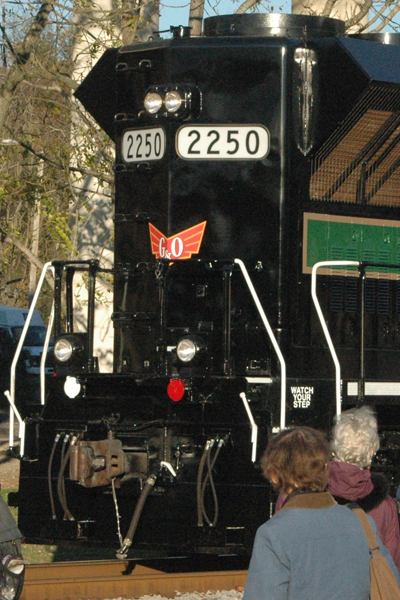 |
 |
 |
| From the downtown area, the line continues east, eventually to an old quarry and now an industrial park just past where the Holston and French Broad Rivers join to form the Tennessee River. K&HR has a large bridge over the Holston just north of its mouth. Thus Knoxville is a junior Pittsburgh, and you now know why K&HR's tourist train is called the Three Rivers Rambler. It operates from a riverfront depot loading area below downtown and runs east across the Holston bridge. So, the K&HR trackage we covered -- from the north-end NS connection near Coster -- as far as the downtown loading area was "rare mileage." (Several of us had ridden the Rambler route after the 2007 NRHS Chattanooga convention when K&HR hosted a special Railfan Day.)
The train ride was combined with dinner at Calhoun's on the River, a riverside restaurant near the Rambler's loading area and just below the Gay Street bridge, Gay being a main drag in downtown Knoxville to the north. From the north end of the city, TWO train consists went south on the K&HR, eventually all the way to the run-around track east of the Holston bridge, and then back downtown, where they discharged all passengers for dinner. After dinner, we walked or were bused back to the hotel. Mr. Claussen has two operable steam locomotives (plus one in storage), and each handled a short train on the two-consist Lexington Group excursion. I rode the one pulled by K&HR's most recent in-service engine, Southern 2-8-0 No. 154, an 1890 Schenectady product which had been displayed in a Knoxville park since 1953 and was donated to G&O for refurbishment in 2008. She's been in service since July 2010. Our consist was all-NS: diner Kentucky; coaches 29, 28, and 26, and business car 21 West Virginia—the diner being the only car not on our Chattanooga train (Kentucky being on NS's business car train which was already in town for the Saturday Asheville run). The other K&HR excursion consist was pulled by 2-8-0 No. 203, lettered for former owner Washington & Lincolnton. She is a 1925 Baldwin, and we'd ridden behind her on our 2007 Rambler ride. G&O also owns a 1923 Baldwin 4-4-0 of SP (T&NO) heritage, which was at Stone Mountain in Georgia for a long time, last operating there in 1983. To begin the outing, we bused from the hotel to Coster to board the trains. Ours pushed back at 2:38 p.m., left the Coster area at 3:02. This is a photo of the other train, already boarded at Coster, with W&L 203 up front. A K&HR SW1500 is behind the ex-IC caboose, having towed the train up to the loading track, western-most of several NS tracks at the north end of the yard. |
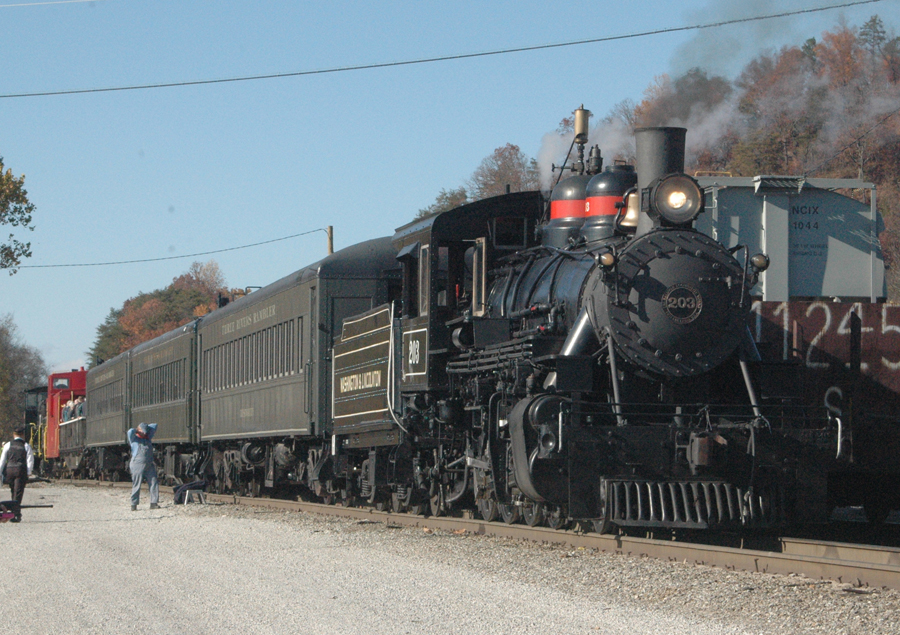 |
| As our train got under way, we passed this NS freight getting re-crewed so it could head west for Harriman Jct. and the famed Rat Hole line. |
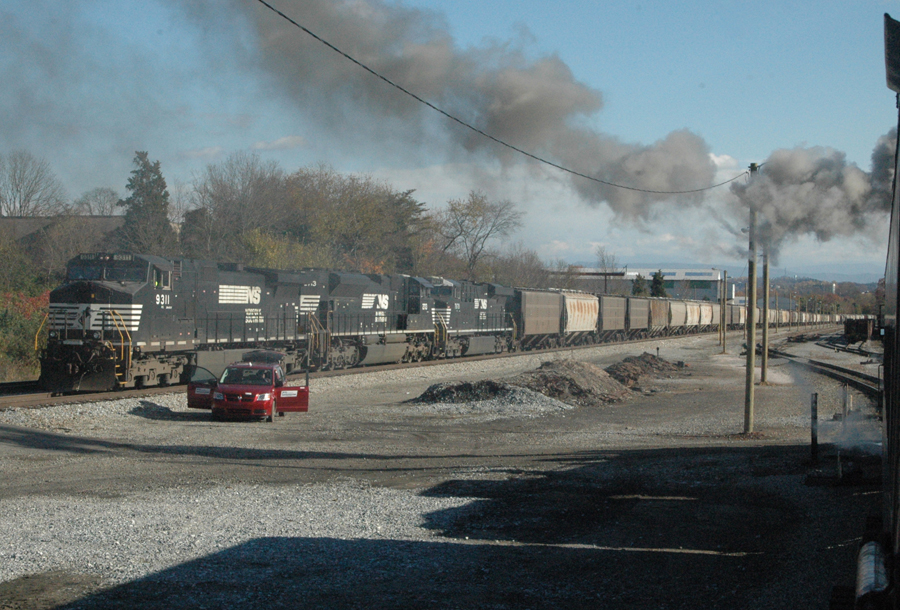 |
| Here we go west, about to pass the steel plant K&HR serves, about 3:05 p.m. |
 |
| Here we are curving south in a creek valley on the west side of town, near where K&HR goes under NS's Chattanooga line, which we passed at 3:23. |
 |
| Bill Schafer is explaining something to Chuck Weinstock. |
 |
| We are now along the Tennessee River, approaching downtown. The arches are on the Henley St.-Chapman Hwy. bridge, one of two downtown street bridges over the river, which was undergoing a long re-deckinig and rebuilding. |
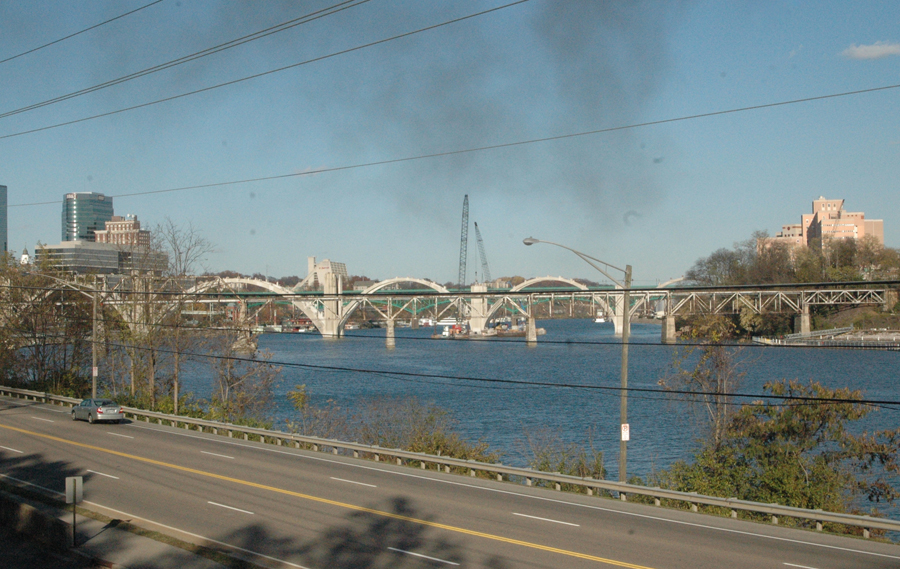 |
| We are just below the football stadium as we cross Neyland Drive, which is essentially a riverfront road. We have already gone under CSX's former L&N bridge, at 3:28. |
 |
| In this eastward view, if you look carefully, you can see closest to us NS's Alcoa branch bridge, then the under-reconstruction arched street bridge, then the (green) Gay Street bridge; Gay St. turns east and becomes Sevier Avenue on the south side of the river. Aside from our brief stop in 2007 to ride the Rambler, I had not been back to Knoxville since I left there in June 1966. |
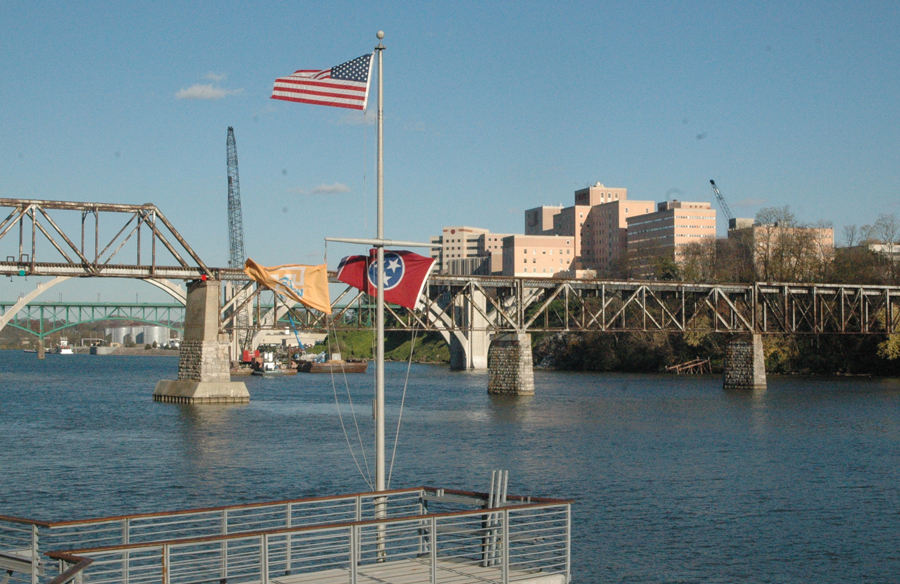 |
| Here's the Alcoa branch bridge closer up; we'll ride across it on the meeting's finale, on Sunday Nov. 13th. |
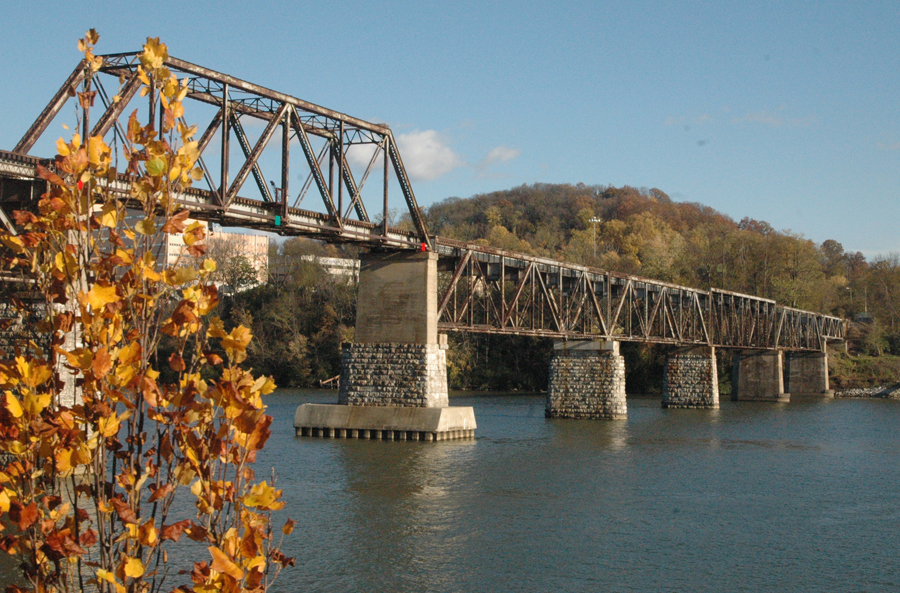 |
| The arches were to survive, but this close-up shows the immensity of the rebuilding of the street bridge. We are approaching our photo run-by spot, where we halted at 3:42. |
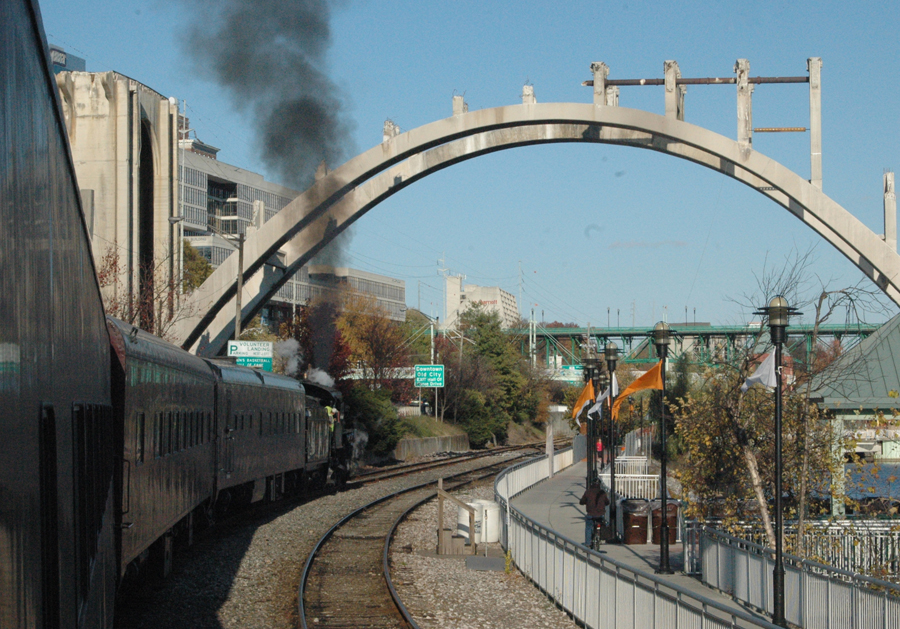 |
| We've unloaded, and KLW's diesel has coupled to our train to pull it back for the run-by. The 203's train is ahead of us, having already unloaded its photographer passengers and pulled ahead. |
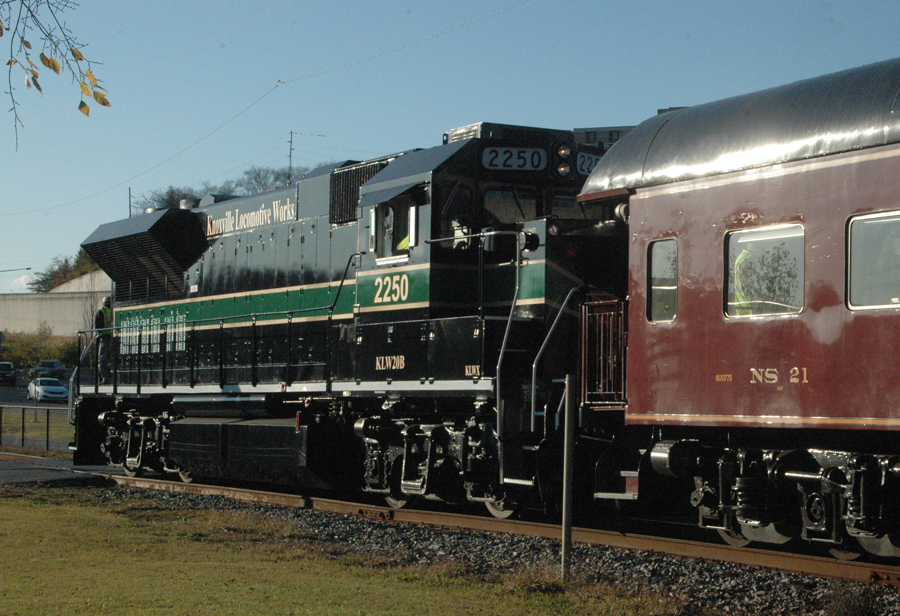 |
| This will be a double run-by -- with TWO trains backing up and pulling past us. The run-bys consumed from 3:34-3:46 and 4:01-4:05, but the logistics of moving 2 trains and re-loading meant we did not leave the area until 5:03. I was in a photo line next to a tree, and by the time we were all done, many of us were chilled by a cold wind coming up the river, but grateful for the unique opportunity. |
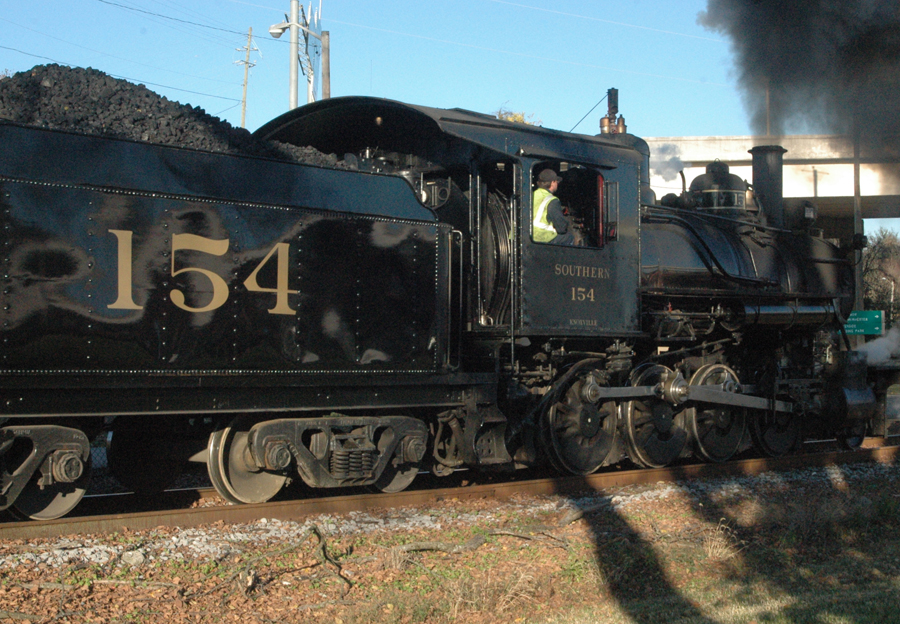 |
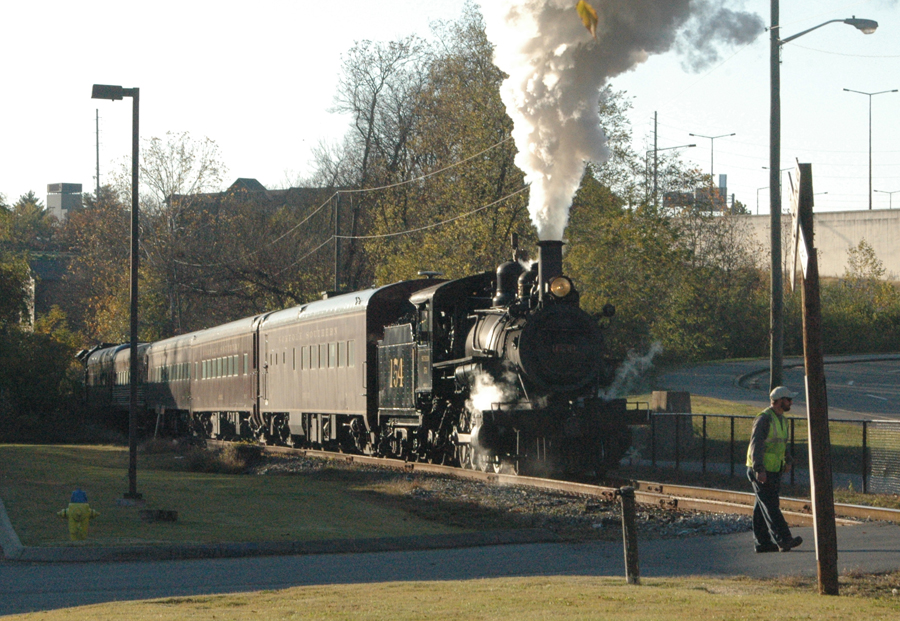 |
| The caboose of 203's train passes us as it backs up. I was working both digital and slide cameras, of course. |
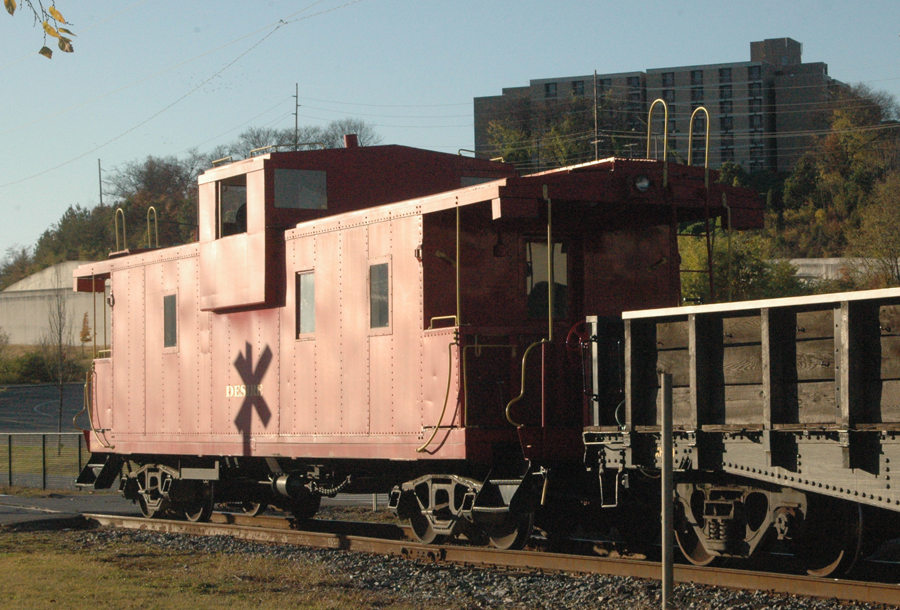 |
| The 203 backs her train past us, then pulls by for the first part of the first run-by pair. |
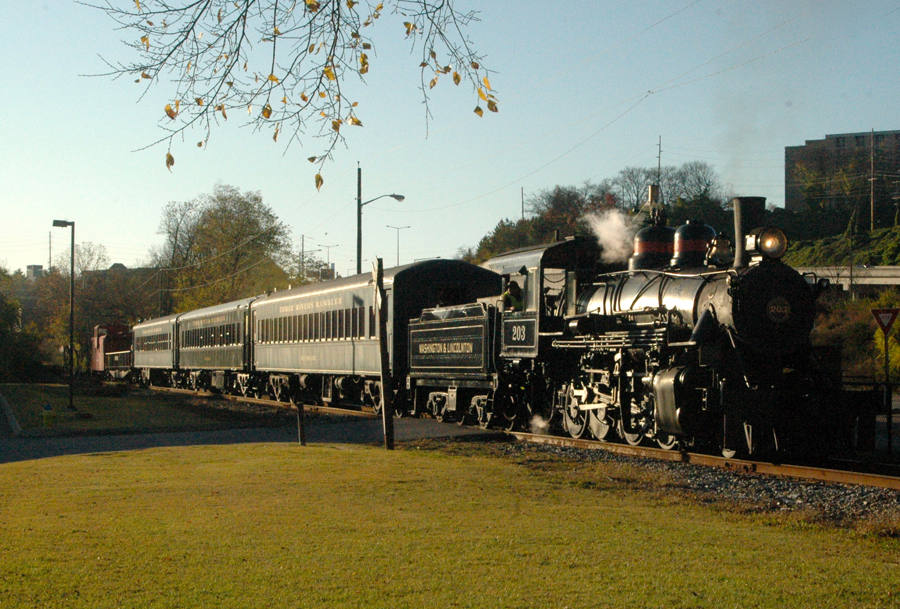 |
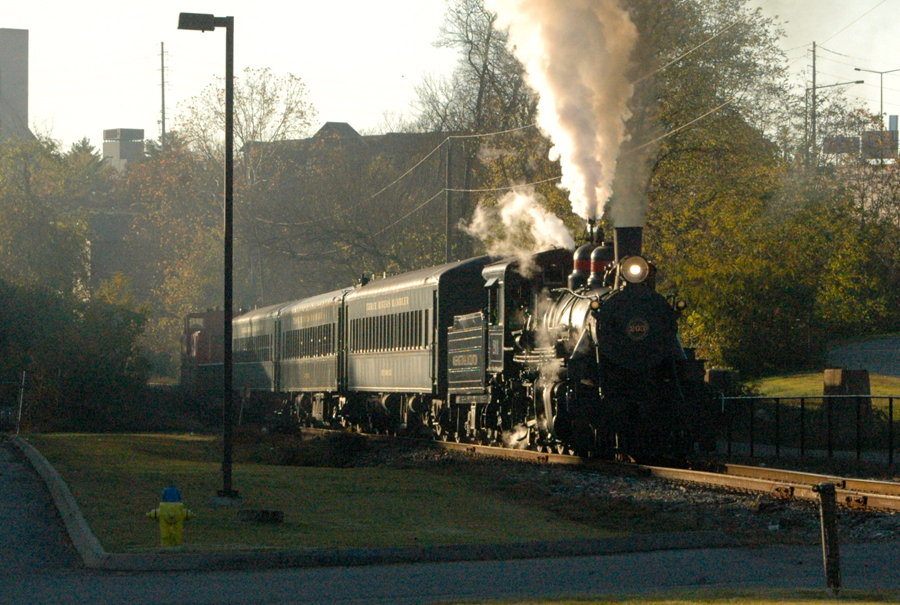 |
 |
| Then it's the 154's turn with "our train." |
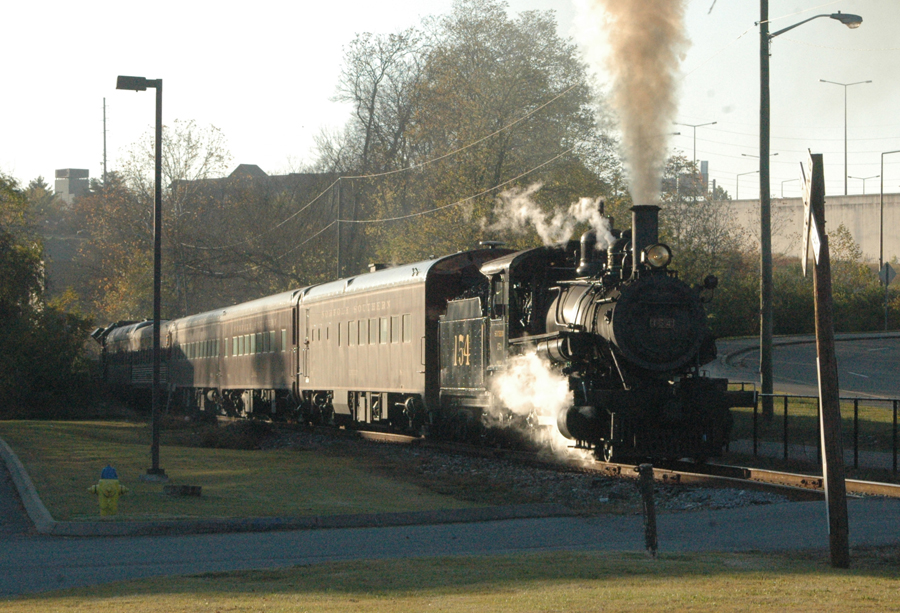 |
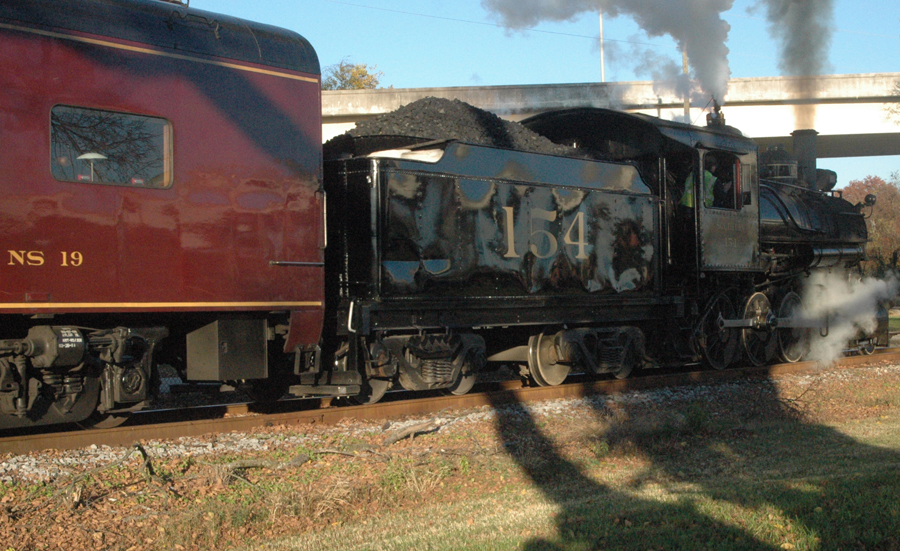 |
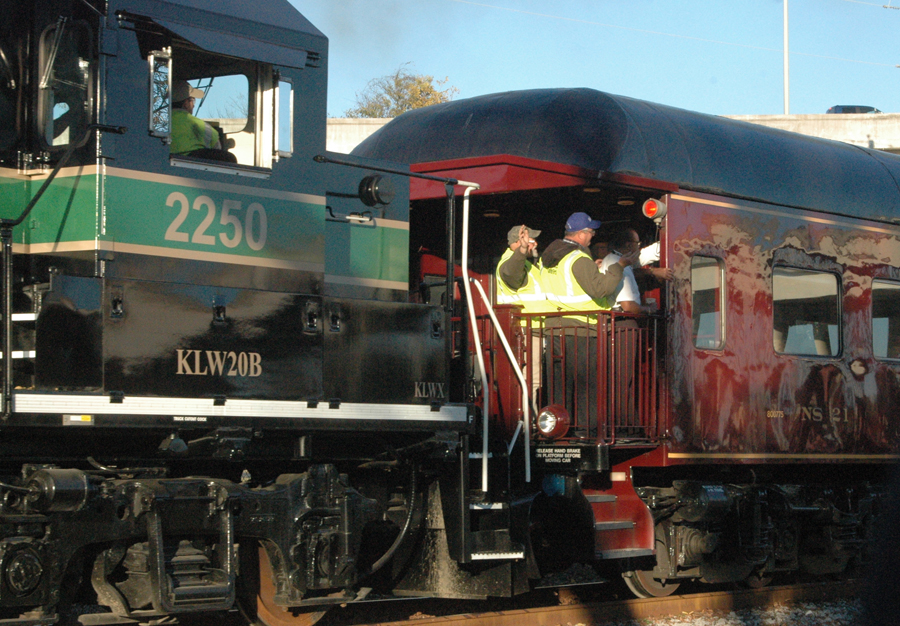 |
| Again thanks to Lexington nametags, I can i.d. G&O's founder Pete Claussen (left) and Riley McCarren, who at one time led Gateway Western and then later, Wisconsin Central Ltd. Many rail professionals are in Lexington Group, but probably don't want to be known as "railfans" despite having a genuine interest in railroading, and its operations, finances, and history. |
 |
| Among those braving the cold were John Gruber of the Center for Railroad Photography and Art (left) and Mike Yuhas, TRAINS and CLASSIC TRAINS Advertising Sales manager. | Friends Brian and Joy Holtz, former Milwaukeeans, were on board. Brian worked for Schlitz, then SP in California, and retired in Hot Springs, Ark., after serving short line Arkansas Midland. |
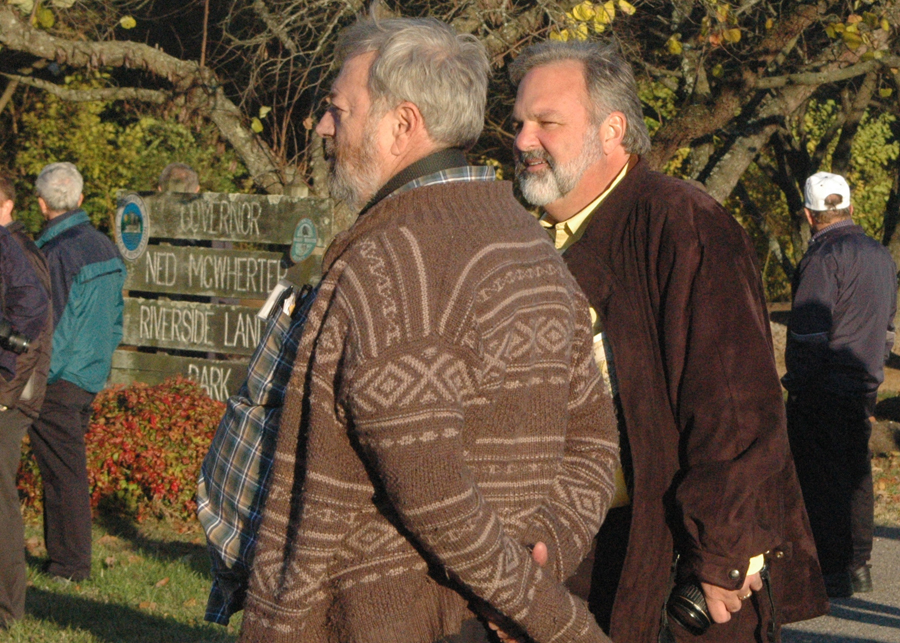 |
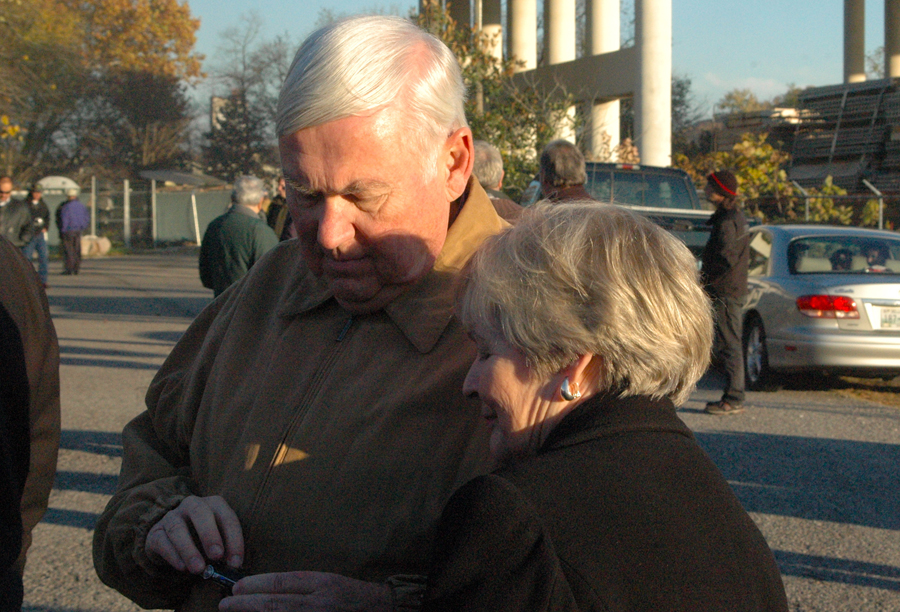 |
| Don Hofsommer, a history professor at St. Cloud (Minn.) State University, is the leader of the Lexington Group. | If you look right in the center, TRAINS Senior Editor Matt Van Hattem has his hand on the siderail as he looks to his left from the gondola on the 203's train. Chuck Weinstock is at lower left. |
 |
 |
| It was deep into dusk, just after sunset at 5:25 when we curved to the left through the woods and crossed the high Holston River bridge. |
 |
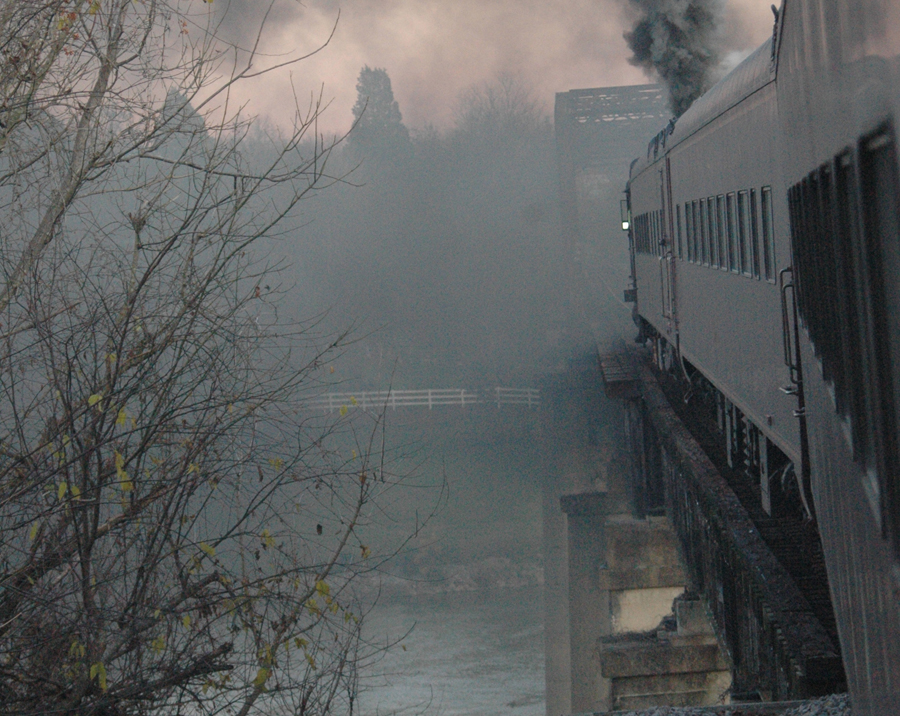 |
| The first photo below looks east on the French Broad River toward North Carolina, as we pass over the mouth of the Holston, while the second view looks west into the sunset at the beginning of the Tennessee River. |
 |
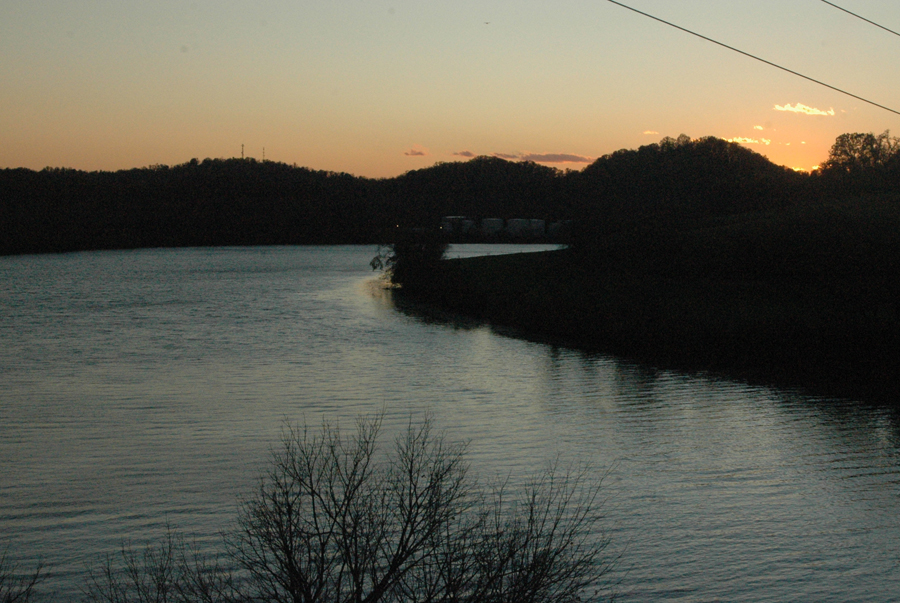 |
| Now after sunset and as we back up toward downtown, Bill Schafer (left) and Bennett Levin, owner of Juniata Terminal Co. in Philadelphia and its two original Pennsylvania Railroad E8's, discuss some matter of importance, possibly a future trip of the E8's on NS. |
 |
| Dinner was at Calhoun's on the River, a local chain now with 8 outlets, at its original site right next to the K&HR track below downtown. It specializes in BBQ ribs, and we had a table of 10 friends from 7 states, shown in several photos as we awaited our food to conclude a great afternoon and evening. |
 |
| Yours truly at left, Louis Saillard of Baton Rouge, La., in center, George Werner of Houston at right. | Steve and Maxine Patterson of suburban Denver; he's retired from BNSF, originally from Kingsport, Tenn. |
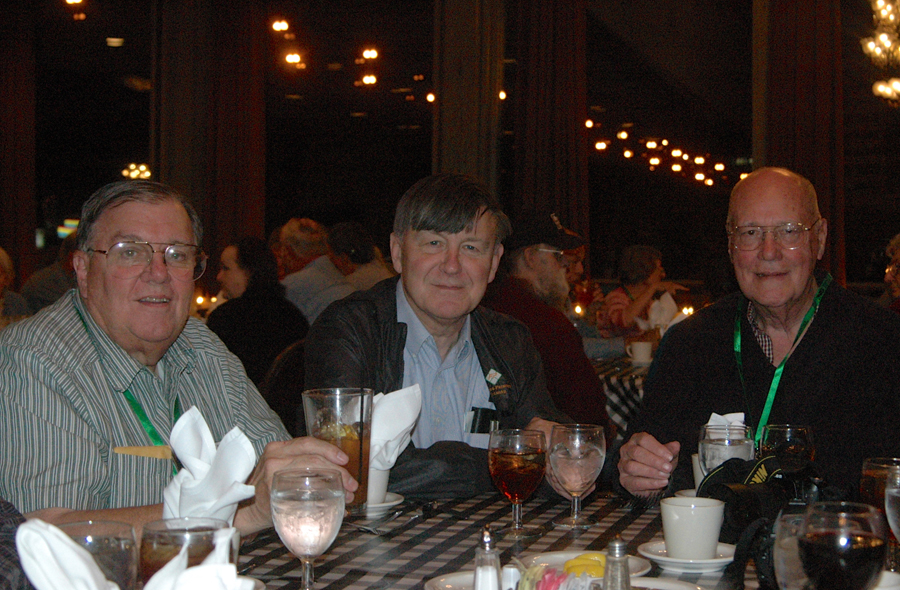 |
 |
| Pete and Kathy Stonitsch of Waukesha | Al Butler (left) of Boston and Pete Stonitsch. |
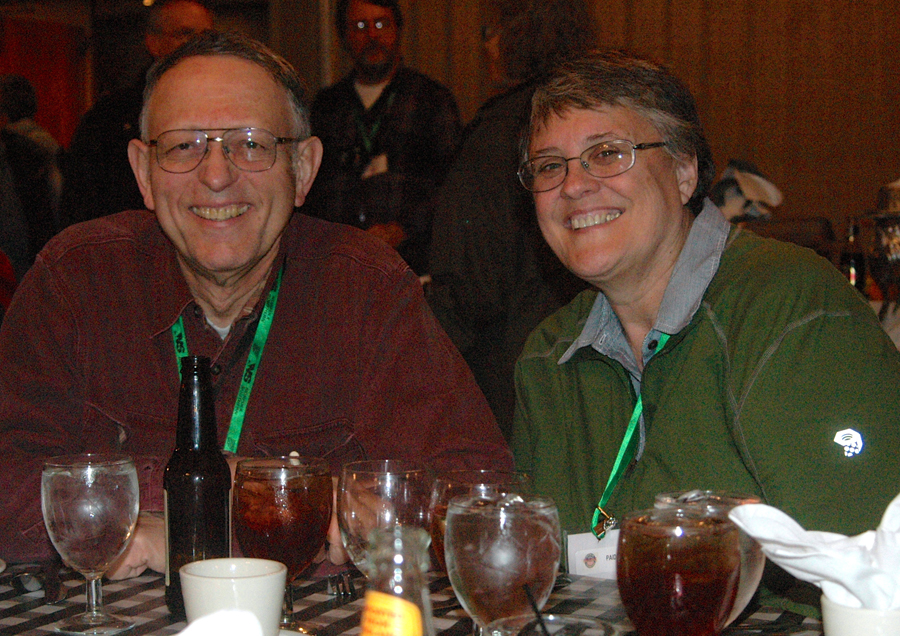 |
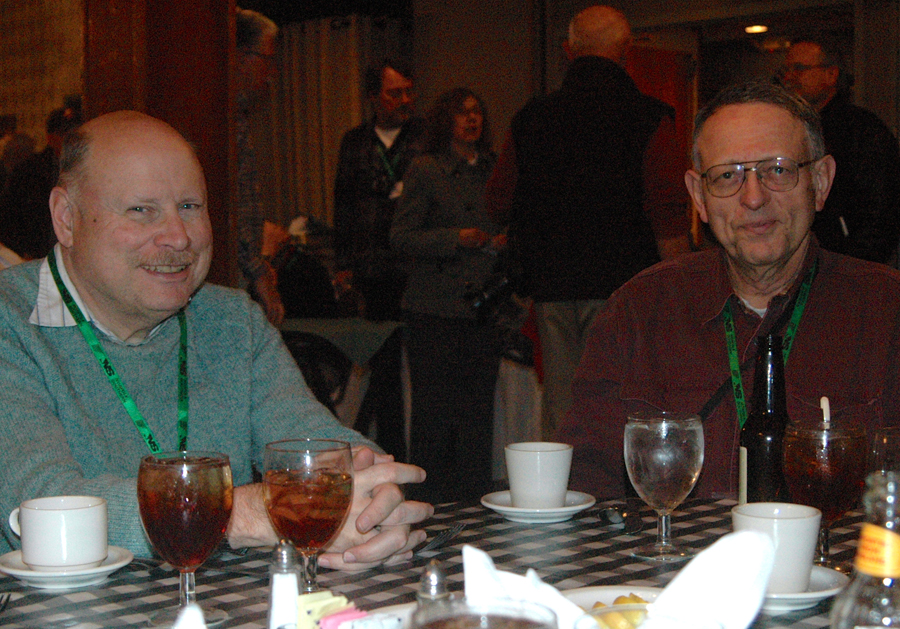 |
| The traveling trio: Rick Moser, Chuck Weinstock, and this writer. |
 |
This page was designed and is maintained by Mike Condren. If you have materials
that you would like to contribute, contact me at mcondren@cbu.edu